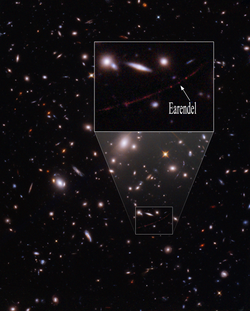エアレンデル
原文と比べた結果、この記事には多数の(または内容の大部分に影響ある)誤訳があることが判明しています。情報の利用には注意してください。(2022年7月) |
エアレンデル(Earendel)またはWHL0137-LSは、くじら座の恒星である。2022年にハッブル宇宙望遠鏡により発見され、共動距離280億光年(86億パーセク)と既知の恒星の中では最も遠く、最も初期の恒星である[2][3]。これ以前の既知の最遠の恒星は、2018年にハッブル宇宙望遠鏡が発見したイカロスで、共動距離は144億光年(44億パーセク)であった[4][3]。
| エアレンデル | |
|---|---|

| |
ハッブル宇宙望遠鏡による画像(2022年3月30日公開)
| |
| 仮符号・別名 | WHL0137-LS |
| 星座 | くじら座 |
| 見かけの等級 (mv) | 27.2[1] |
| 位置 元期:J2000.0 | |
| 赤経 (RA, α) | 01h 37m 23.232s[1] |
| 赤緯 (Dec, δ) | −8° 27′ 52.20″[1] |
| 赤方偏移 | 6.2 |
| 距離 | 280 億光年[2] |
| 物理的性質 | |
| 質量 | 50-100 M☉[1] |
| 表面温度 | >20,000 K[1] |
| ■Template (■ノート ■解説) ■Project | |
観測
編集ハッブル宇宙望遠鏡によるエアレンデルの発見は、2022年3月30日に報告された[1][5]。この恒星と地球の間にあった銀河団WHL0137-08による重力レンズ効果により、恒星の光が増幅されたことにより検出された[3]。レンズ効果のコンピュータシミュレーションでは、エアレンデルの明るさは、1000倍から40000倍に増幅されたと計算された[3]。ハッブル宇宙望遠鏡が露出したのは2016年6月7日、同年7月17日、2019年11月4日、同年11月27日だった[6]。
この恒星は、発見者により、古英語で「明けの明星」を意味する「エアレンデル」(アウルヴァンディル)と綽名された[1][7]。また、J・R・R・トールキンの『シルマリルの物語』には同じ古英語エアレンデル(Ēarendel)に由来する半エルフの航海者エアレンディル(Eärendil)が登場し、星の輝きをもつ宝石シルマリルを携え明星となって空を航海しているとされる。アメリカ航空宇宙局の天文学者ミッチェル・サラーは、この名前がトールキンの作品に触発されたものであることを保証した[8]。この恒星が所属する銀河であるWHL0137-zD1は、重力レンズにより、その光が長い三日月のように歪められて見えるため、"Sunrise Arc"と綽名されている[9][10]。
ハッブル宇宙望遠鏡とジェームズ・ウェッブ宇宙望遠鏡によるさらなる観測により、この恒星の詳しい性質を明らかにすることが提案されている[1][11]。ジェームズ・ウェッブ宇宙望遠鏡の高い感度により、エアレンデルの恒星スペクトルの分析が可能となり、これが本当に単一の恒星かどうか決定できることが期待されている[2][12]。またスペクトル分析により、もし水素やヘリウムより重い元素があった場合には、それが明らかとなる[9]。
物理的性質
編集エアレンデルから検出される光は、ビッグバンから9億年後に放出されたものである。赤方偏移は6.2 ± 0.1と測定され、これは、エアレンデルからの光が129億年後に地球に到達していることを意味する[1][13][14]。しかし、宇宙の膨張のため、観測された恒星の位置は、現在では280億光年離れている[2]。これまで、最遠の天体だったイカロスの赤方偏移は1.49で、現在は144億光年離れた位置にある。
エアレンデルの質量は、恐らく50-100太陽質量の間と見積もられている[15]。その大きな質量のため、形成から数100万年後には超新星爆発を起こすと考えられている[15][16]。恒星表面の有効温度は少なくとも20,000 Kである[1]。また可能性は低いが、種族IIIの恒星である可能性があり、その場合、原初の元素である水素とヘリウム以外の元素はほぼ持たないことになる[3]。
関連項目
編集出典
編集- ^ a b c d e f g h i j Welch, Brian (21 January 2022). “A Highly Magnified Star at Redshift 6.2”. Nature 603 (7903): 1–50. doi:10.1038/s41586-022-04449-y. PMID 35354998. オリジナルの30 March 2022時点におけるアーカイブ。 2022年3月30日閲覧。.
- ^ a b c d Kabir (2022年3月31日). “Hubble Detects Earendel, The Farthest Star Ever Seen. It's 28 Billion Light Years Away”. ABP Live. ABP News. 2022年3月31日時点のオリジナルよりアーカイブ。2022年3月31日閲覧。
- ^ a b c d e Gianopoulos, Andrea (2022年3月30日). “Record Broken: Hubble Spots Farthest Star Ever Seen”. NASA. オリジナルの2022年3月30日時点におけるアーカイブ。 2022年3月30日閲覧。
- ^ Staff (2018年). “Cosmological information and results: redshift z=1.49”. Wolfram Alpha. 2018年4月4日閲覧。
- ^ “Record Broken: Hubble Spots Farthest Star Ever Seen”. Space Telescope Science Institute (NASA). (2022年3月30日). オリジナルの2022年3月30日時点におけるアーカイブ。 2022年3月30日閲覧。
- ^ “Lensed Star Earendel”. HubbleSite.org (2022年3月30日). 2022年4月2日閲覧。
- ^ Parks, Jake (2022年3月30日). “Hubble spots the farthest star ever seen”. Astronomy. オリジナルの2022年3月31日時点におけるアーカイブ。 2022年3月30日閲覧。
- ^ Gohd, Chelsea (2022年3月31日). “Meet Earendel: Hubble telescope's distant star discovery gets a Tolkien-inspired name” (英語). Space.com. 2022年3月31日時点のオリジナルよりアーカイブ。2022年3月31日閲覧。
- ^ a b Rauchhaupt, Ulf von (2022年3月31日). “Der fruheste Stern [The earliest star]” (ドイツ語). オリジナルの2022年3月31日時点におけるアーカイブ。 2022年3月31日閲覧。
- ^ Rennert, David (2022年3月31日). “Hubble-Teleskop erspahte den mit Abstand fernsten Stern” [Hubble telescope spotted by far the most distant star] (ドイツ語). Der Standard. 2022年4月3日閲覧。
- ^ Coe, Dan; Welch, Brian; Acebron, Ana; Avila, Roberto; Bradac, Marusa; Bradley, Larry; Diego, Jose M.; Dimauro, Paola et al. (2021). “Monitoring Earendel, the Lensed z 6 Star”. HST Proposal: 16668. Bibcode: 2021hst..prop16668C.
- ^ Starr, Michelle (2022年3月30日). “The Most Distant Single Star Was Just Detected, as Ancient as The Cosmic Dawn”. ScienceAlert (Nature). doi:10.1038/s41586-022-04449-y. オリジナルの2022年3月31日時点におけるアーカイブ。 2022年3月30日閲覧。
- ^ Letzter, Rafi (2022年3月30日). “Meet Earendel, the most distant star ever detected”. The Verge. オリジナルの2022年3月30日時点におけるアーカイブ。 2022年3月30日閲覧。
- ^ Timmer, John (2022年3月30日). “Hubble picks up the most distant star yet observed”. Nature (Ars Technica). doi:10.1038/s41586-022-04449-y. オリジナルの2022年3月30日時点におけるアーカイブ。 2022年3月30日閲覧。
- ^ a b Konitzer, Franziska (2022年3月30日). “Entferntester Stern dank 1000-facher Vergroserung entdeckt” [Furthest star discovered thanks to 1000x magnification] (ドイツ語). Spektrum der Wissenschaft. 2022年3月31日時点のオリジナルよりアーカイブ。2022年3月31日閲覧。
- ^ Dunn, Marcia (2022年3月30日). “This is Earendel, the most distant star ever seen by humans”. Los Angeles Times. 2022年3月30日時点のオリジナルよりアーカイブ。2022年3月31日閲覧。